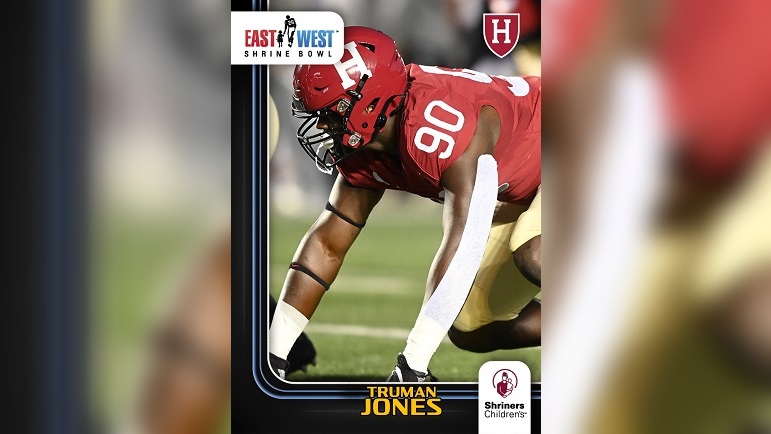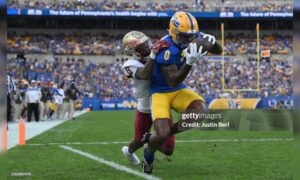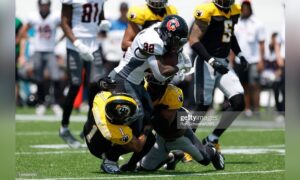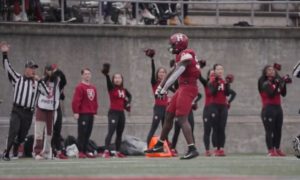While Harvard and Yale compete every season in what is one of the oldest and most storied rivalries, the Crimson are not traditionally a household name in the department of producing NFL talent, save for Ryan Fitzpatrick, Kyle Juszczyk, to name a few. Edge rusher Truman Jones, fresh off a dominant career in Cambridge, Massachusetts, arrived in Las Vegas with sights on changing that history.
The Atlanta native finished a productive four year stint at Harvard, posting 88 tackles, 28.5 tackles for losses, 14.5 sacks, four passes defended, three forced fumbles, a fumble recovery, and four blocked kicks. Following his dominant senior season, in which he recorded 13 tackles for loss and three blocked kicks in just 10 games, Jones was named a unanimous First Team All-Ivy League selection and was awarded the Bulger Lowe Award, given to the top defensive player in New England. Jones was also nominated as a semi-finalist for the William V. Campbell Trophy, given to the player who showed the best combination of academics, community service, and on field performance.
A three year starter in both football and lacrosse at Westminster High School in Atlanta, the latter in which he was a multi-year captain and received All-American honors at the high school level. In coming to Harvard, Jones understood that he was attending one of America’s most prestigious institutions, one which would present him with equally difficult challenges academically and athletically.
“Yeah, definitely,” Jones said. “It was a challenge freshman year just because so much more is expected of you in both spheres, academically and athletically. I think we’re just grateful for my high school for preparing me that I was more prepared in classes than I thought I would be. I had good study habits formed up to that point, so then I was able to help my teammates, help my classmates and kind of elevate them in terms of football.
“It was just a huge jump coming from high school ball Atlanta to, you know, Harvard where it’s Division One. Obviously, I competed against great players, a lot of guys who could’ve played Power Five and just the speed of the game and the intensity was so much different. So, I was a linebacker when I first came in freshman year and just really learned how to, like, how to practice, how to approach football and how to relook at the game. And then that prepared me for sophomore year and then how to start a game back.”
Set to graduate with a degree in biomedical engineering, Jones had aspirations of becoming a doctor before realizing that playing football professionally was a viable option following his senior season. Even as early as his freshman year, Jones, dealing with his own struggles of changing positions in adding weight in his transition to the collegiate level, was already committed to helping teammates. His joint commitment to improving the Harvard football program both on and off the field was vindicated when he was named the 148th captain in the Crimson’s storied history.
“It was really an honor,” Jones said. “It’s something that we do at the end of every season, where the whole team will vote on who’s the next captain. Just being looked upon in that role and really being respected in that way, it’s like I always thought of myself as someone who just came in and kind of did the work, wasn’t necessarily a vocal leader, but just trying to do things the right way and go about the game the right way. So to see that it pay off was an honor. I remember coming in, I was talking to so many of my classmates and everyone was the captain at their previous high school. The smartest and the best player and now we’re all here, and you have to elevate again to another level. So, being able to be the captain amongst people who are all captains beforehand is just really an honor.”
Originally an off-ball linebacker as a freshman, Jones was quickly forced to gain weight in his transition to the edge position, remarking that he gained 20 to 25 pounds within that year, gaining a steady five pounds per season in each year since. He weighed in at 251 pounds at the Shrine Bowl measurements, along with 6’2 ½” height and 33 ⅝” arm length, a size that he reportedly feels comfortable at in his transition to the next level.
“Yeah. I mean, I’m honestly pretty flexible,” Jones said. “I feel very comfortable with this weight, and I’ve settled in over the past three years. When I first got into 245 it was a little uncomfortable. I had to condition more and take care of my body, but now I’m very comfortable with this weight and feel like there’s room to either go up or down 10 to 15 pounds.”
As for scheme fit, Jones stated that he currently feels most comfortable as a 4-3 defensive end, playing with his hand in the dirt, as that is where a vast majority of his experience came at Harvard. He cited playing in coverage as the hardest part of transitioning into becoming a 3-4 outside linebacker, providing sentiments that while he has a ways to go in developing his understanding of pass concepts, he didn’t feel like a fish out of water when thrown into stand-up edge rusher roles this past season.
“Yeah, at the moment I’d say probably 4-3 defensive end, with my hand in the ground,” Jones said. “Just cause that’s what I did for four years at Harvard. This past season we put in a three-down front, so I played some outside backer and, you know, that was good. It brought me back to my freshman year days, but I really didn’t feel out of place, there’s just still a lot to learn there in terms of pass concepts and how to guard receivers one on one.”
Jones credited his hand usage and ability to anchor and set the edge in the run game as his best trait, while citing improving as a pass rusher as his main goal ahead of entering the NFL. He expanded to talk about gaining more experience in rushing from the right side, developing more variance to his pass rush plan through working on new moves and perfecting those that he already has in the toolbox.
“Yeah, I think my biggest strength is using my hands on one blocker and being able to really set the edge and prevent them from taking the edge,” Jones said. “And I think just the ability as well to be more athletic. Something that I need to work on is probably gonna be pass rush. I need to develop some more movement and a little bit more diversity as well. Rushing from the right-hand side, I played on the left side all of college, so I’m hoping to expand all that at the next level.”
Jones plays with powerful punch and technically sound hand usage in the run game, and his ability to set the edge has been evident at times in Las Vegas. With 14.5 sacks in 30 games of defensive snaps, Jones averaged nearly a sack every other game throughout his career, solid production for a player who had never played the position prior to his freshman year of college.
Jones has all the athletic tools and a proven work ethic to suggest that improvement, particularly through an expanded pass rush arsenal, could help Jones carve out a role at the next level. At the time of our interview on Friday, January 27, Truman Jones had not yet received a combine invite, although he was hoping to parlay a solid Shrine Bowl practice week into gaining a trip to Lucas Oil Stadium.








